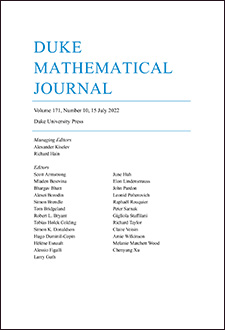Abstract
Let be a reductive group, and let denote the moduli stack of -bundles on a smooth projective curve. We begin the study of the singularities of a canonical compactification of due to Drinfeld (unpublished), which we refer to as the Drinfeld–Lafforgue–Vinberg compactification . For and , certain smooth open substacks of this compactification have already appeared in the work of Drinfeld and Lafforgue on the Langlands correspondence for function fields. The stack is, however, already singular for ; questions about its singularities arise naturally in the geometric Langlands program, and form the topic of the present article. Drinfeld’s definition of for a general reductive group relies on the Vinberg semigroup of (we will study this case in a forthcoming article). In the present article we focus on the case , where the compactification can alternatively be viewed as a canonical one-parameter degeneration of the moduli space of -bundles. We study the singularities of this one-parameter degeneration via the weight-monodromy theory of its nearby cycles. We give an explicit description of the nearby cycles sheaf together with its monodromy action in terms of certain novel perverse sheaves which we call Picard–Lefschetz oscillators and which govern the singularities of . We then use this description to determine the intersection cohomology sheaf of and other invariants of its singularities. Our proofs rely on the construction of certain local models which themselves form one-parameter families of spaces which are factorizable in the sense of Beilinson and Drinfeld. We also briefly discuss the relationship of our results for with the miraculous duality of Drinfeld and Gaitsgory in the geometric Langlands program, as well as two applications of our results to the classical theory on the level of functions: to Drinfeld’s and Wang’s strange invariant bilinear form on the space of automorphic forms, and to the categorification of the Bernstein asymptotics map studied by Bezrukavnikov and Kazhdan as well as by Sakellaridis and Venkatesh.
Citation
Simon Schieder. "Picard–Lefschetz oscillators for the Drinfeld–Lafforgue–Vinberg degeneration for ." Duke Math. J. 167 (5) 835 - 921, 1 April 2018. https://doi.org/10.1215/00127094-2017-0044
Information





